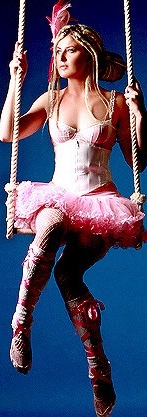authenticity issues in
THE SEX TRADE

by
ZAHRA STARDUST
________________________________________
Zahra Stardust is a writer and sex worker. Her
essays can be found at www.zahrastardust.com
and zahra.org.au.
Said of Zahra: "Sexy beautiful bodies are an expensive
dime a dozen; what distinguishes this women is that she can
think and write."
WHAT
IS FAKE AND REAL IN THE SEX INDUSTRY
As
someone who works in the sex industry – in spaces that
purport to be real as well as spaces that are accused of as
being fake – it seems like there is no distinct line between
the two. As  someone
who works with a body that is sometimes perceived as real and
other times read as fake – it seems that the bodies which
move across these spaces are equally fluid.
someone
who works with a body that is sometimes perceived as real and
other times read as fake – it seems that the bodies which
move across these spaces are equally fluid.
As
someone whose pink bits have been airbrushed in magazines, but
which have also been on explicit display; who performs both
with and without make-up; whose real name is my stage name,
distinctions between fake and real don’t always make sense.
I experience
pleasure at work in the mainstream sex industry that I certainly
perceive as real. This pleasure comes from physical sensations
(lactic acid, endorphins, sweat, carpet burn, whipping hair,
a double ended dildo angled against my g-spot, real orgasms)
but also from the thrill of voyeurism (exhibitionism, cameras,
being naked in front of thousands of people).
Pleasure
comes from creative aesthetics (coordinating colours, angles,
props and shapes) and the kick of doing something that is (to
some) taboo. I consider that pleasure a genuine part of my own
sexuality. Sure, it’s work – and during shows I
am also thinking about choreography, musicality, crowd control,
not falling over, pole grip, camera angles, the audience member
who is wandering off with my g-string – but work and pleasure
are not mutually exclusive.
Yes,
it can be mundane, repetitive and sometimes I end up with pole
bruises, aching muscles and an intolerance for drunk men, but
I use the stage as a platform to explore my own desires, and
this assumption that what we do at work and the pleasure we
experience from it isn’t real must be problematized. My
vagina will tell you otherwise.
At
the same time, websites that purport to depict real or redefined
beauty, often seem to be just as conventionalized as the mainstream
genres they criticize. Alternative nude modeling site Suicide
Girls gives calculated instructions on their website about the
kinds of photos, make-up and aesthetic sets they accept: tasteful,
picture perfect shoots with ‘a little bit of face powder
and mascara and freshly dyed hair, but specifically not cheap
wig(s), top hats, stripper shoes, food or things that look cheesy,
gross or creepy.
Similarly,
the girl next door look of the Australian all-female explicit
adult site Abby
Winters represents an alternative to glamour
photography, featuring make-up-less, amateur adult models –
but models are still required to cover up hair re-growth, remove
piercings, and not have any scratches, marks or mosquito bites
for the shoot in order to appear healthy.
Other
sites I’ve shot for speak about the importance of models
representing their own sexuality, but then go on to qualify:
“We might get you to tone down the eye make up a bit,”
“Maybe don’t talk about politics,” “Lesbians
don’t really use double-enders do they?” One company
asked me repeatedly to stop wearing frills.
In
doing so, these sites produce bodies of a particular class,
size and appropriate femininity, which are marketed as real,
but which are equally constructed, conventionalized and cultivated.
This fear of replicating cheesy, predictable mainstream porn
means that depictions of real sexuality are often similarly
clichéd, albeit with a different set of aesthetics.
In
their avoidance of the mainstream (whatever that means), alternative
porn (whether it brands itself queer, feminist or erotica for
women) can sometimes replicate and reinforce what Gayle Rubin
calls “Good, Normal, Natural, Blessed Sexuality:”
the sex is vanilla and involves only bodies (without objects
or toys). Sex occurs in the home, between members of the same
generation and only within couples. The scenes are soft, gentle,
usually in natural light and every-day clothes (which in my
experience means we are expected to bring Bonds underwear).
 To
think that this could be any more real than mainstream porn
seems strange to me, especially when it is produced in an environment
that is completely staged: our movements are restricted by camera
angles, someone is standing beside us operating the equipment,
many of us are professionals pretending to be amateur, and in
true documentary style, we are expected to cum on cue. These
kinds of websites are marketable and loveable because they refuse
to define themselves as porn – even though, as Annie Sprinkle
said in the Herstory of Porn, the difference between
erotica and porn “is all in the lighting!”
To
think that this could be any more real than mainstream porn
seems strange to me, especially when it is produced in an environment
that is completely staged: our movements are restricted by camera
angles, someone is standing beside us operating the equipment,
many of us are professionals pretending to be amateur, and in
true documentary style, we are expected to cum on cue. These
kinds of websites are marketable and loveable because they refuse
to define themselves as porn – even though, as Annie Sprinkle
said in the Herstory of Porn, the difference between
erotica and porn “is all in the lighting!”
It
is an important goal to make sexually explicit material that
does not prescribe unrealistic standards, perpetuate hegemonic
gender stereotypes or marginalize diverse sexualities. But many
of us in the sex industry will tell you that those stereotypes
and marginalization come – not from audiences or clients
– but from public reductive readings of our work and stringent
legal frameworks.
These
frameworks determine which bodies and sexual practices can legally
be portrayed and whose voices are heard or silenced. Callous
distinctions between fake and real present un-nuanced and uncritical
readings of the sex industry and contribute to regressive laws.
Sure,
we may play with, embody and embrace hyper-femininity, but we
are no less authentic, or political, or real, because our lip
gloss is hot pink instead of nude. We don’t need to tone-it-down
to be any more queer, radical or real. Our bodies may look unrealistic
to you, but the labour of preparing for work gives erotic performers
a sentient, working knowledge of gender performativity.
Much
of the time, our work is far from glamorous. I return from work
with smudged mascara, sticky lube, patchy fake tan, knotty hair,
smelling like sweat and vaginal fluid – and the customers
experience this up close and personal. My vagina certainly isn’t
airbrushed when I get it out at buck’s parties, complete
with shaving rash, discharge and blonde hair caught in my clit
ring.
Merely
working in this industry gives us access to hundreds of real
bodies – all different, all diverse, all unique. We all
bring real, orgasmic pleasure, to audiences, clients, and readers
(of many genders).
Blaming
certain kinds of femininity and reading our bodies as fake,
normative and indulgent is part of a wider culture that does
not value – and actively ridicules – femininity.
Reading our bodies as fake insults femmes. Many of us feel our
femme presentation is a way of queering femininity; glitter,
six-inch thigh-highs and suspender belts may be far more natural
for many queer femmes than bare feet and beige make-up.
To
call us fake valorizes masculinity above femininity, privileging
masculine or androgynous embodiment (an absence of make-up,
hair-removal and accessories) as real and represents femmes
as superficial and trite dupes who cannot be considered serious
feminist or queer subjects.
The
irony is that you can never win – appropriate femininity
is unachievable. We are either too much or not enough. Our hyper-femininity
is often so far beyond normative feminine ideals that it brings
us social censure – our make-up is too thick, our heels
are too high, our breasts are too large. As Rosalind Gill writes
about women in media, our “bodies are evaluated, scrutinized
and dissected” and are “always at risk of “failing.”
Dyke
porn in particular uses authenticity to market products. Girls
site HotMoviesForHer.com asks in their advertisements, “Sick
of gay-for-pay straight girl sex? So are we” and instead
offers “Real lesbian porn.” This is an important
response to the imitation of homosexual desire by the heterosexual
majority for financial reward, and a reaction to discrimination
and underrepresentation of lesbian sexuality. Further, it raises
important issues about representation, inclusion, accessibility,
and which bodies and sexualities are depicted as erotic or desirable.
However,
these critiques also assume that for adult performers, there
are clear distinctions between what is authentic and performative,
or solid lines between gay and straight, whereas often the protagonists
of girl-girl porn/striptease/sex work – straight and queer
–may experience a blending of both.
Australian
Porn Star Angela White’s research shows that even where
straight-identifying women perform in girl-girl, femme-on-femme
pornography aimed at straight male audiences, the process of
selling sex can queer their heterosexuality. In her interviews
she found that the straight women found themselves enjoying
lesbian experiences in a way that confused their heterosexual
identity, made sexual identity categories redundant and “transform(ED)
their own sexual identity.”
There
is some amazing queer and feminist porn around that is diverse
and celebratory. But I’m not convinced that distinctions
between fake and real are all that useful, or necessary. To
call somebody fake involves a whole set of assumptions about
their body, identity, gender, sexuality and politics, about
what is natural, normal, which sex acts are real, what is authentic
for whom, and how one must look and behave to be feminist or
queer.
It
puts limits on the kinds of sexual encounters and relationships
that are real, discounting the intimate experiences we have
with clients every day. Using the fake/real distinction to denigrate
certain sexualities, shame femininity and blame the sex industry
for gender oppression is too easy. It perpetuates a language
that is whorephobic, femmephobic and slut shaming, which is
being co-opted and reproduced as acceptable in mainstream media,
academia and popular culture, but also (dangerously) by feminists,
queers, and fellow smut-makers.
As
a queer femme sex worker, reading our bodies and sexualities
as fake is offensive to me and my community. Is it acceptable
to you?